Crawinkel No. 1 / Gravincella / Cravunkele
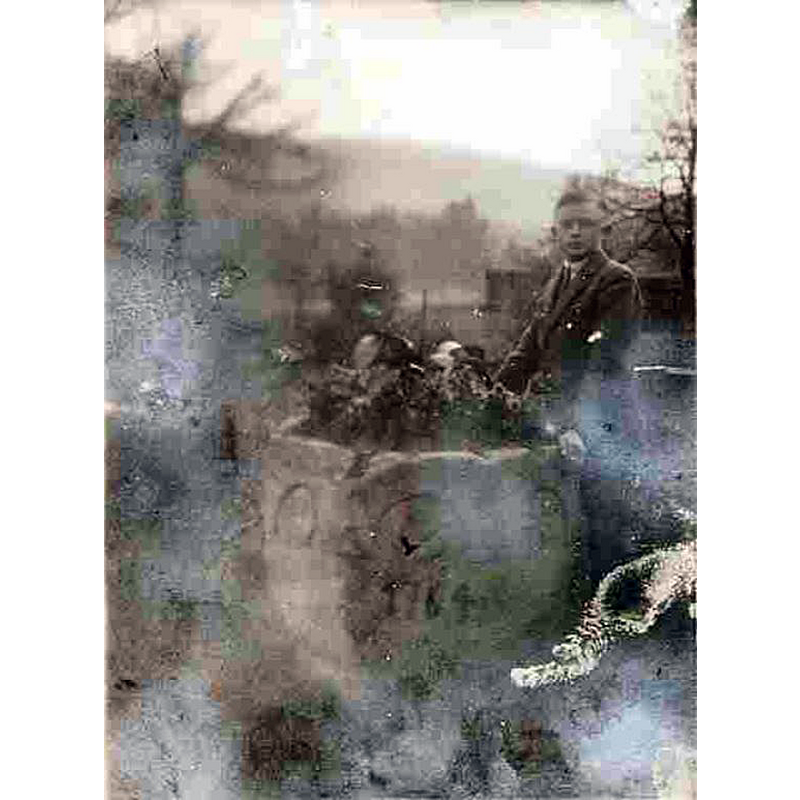
Image copyright © [in the public domain]
Assumed PD
Results: 13 records
design element - architectural - arch-head - round
Scene Description: blank except three of them
Copyright Statement: Image copyright © Klaus-Peter Schambach, 2011
Image Source: digital photograph by Klaus-Peter Schambach, in Ein Stein aus Crawinkel - Auf den Spuren der Geschichte der Christianisierung Thüringens [https://www.cravunkele.de/cravunkele/1764-was-für-ein-stein/] [accessed 24 October 2022]
Copyright Instructions: No known copyright restriction / Fair Dealing
design element - motifs - ball, bead or pellet - in a circle
Scene Description: or, is it a sybol? -- the much-discussed date painted below may have less significance than it is attributed to it by some [cf. FontNotes]
Copyright Statement: Image copyright © Klaus-Peter Schambach, 2011
Image Source: digital photograph by Klaus-Peter Schambach, in Ein Stein aus Crawinkel - Auf den Spuren der Geschichte der Christianisierung Thüringens [https://www.cravunkele.de/cravunkele/1764-was-für-ein-stein/] [accessed 24 October 2022]
Copyright Instructions: No known copyright restriction / Fair Dealing
design element - motifs - floral - 6-petal
Scene Description: some have identified it as a star; the large side hole may have been made to drain the vessel when it was used as planter in the garden [cf. FontNotes]
Copyright Statement: Image copyright © Klaus-Peter Schambach, 2011
Image Source: digital photograph by Klaus-Peter Schambach, in Ein Stein aus Crawinkel - Auf den Spuren der Geschichte der Christianisierung Thüringens [https://www.cravunkele.de/cravunkele/1764-was-für-ein-stein/] [accessed 24 October 2022]
Copyright Instructions: No known copyright restriction / Fair Dealing
human figure - face, head or mask
Scene Description: in one of the arch-heads
Copyright Statement: Image copyright © Klaus-Peter Schambach, 2011
Image Source: digital photograph by Klaus-Peter Schambach, in Ein Stein aus Crawinkel - Auf den Spuren der Geschichte der Christianisierung Thüringens [https://www.cravunkele.de/cravunkele/1764-was-für-ein-stein/] [accessed 24 October 2022]
Copyright Instructions: No known copyright restriction / Fair Dealing
view of basin - interior - detail
Scene Description: the original drain or an added side drain? [cf. FontNotes]
Copyright Statement: Image copyright © Klaus-Peter Schambach, 2011
Image Source: digital photograph by Klaus-Peter Schambach, in Ein Stein aus Crawinkel - Auf den Spuren der Geschichte der Christianisierung Thüringens [https://www.cravunkele.de/cravunkele/1764-was-für-ein-stein/] [accessed 24 October 2022]
Copyright Instructions: No known copyright restriction / Fair Dealing
view of church exterior - southwest view
Scene Description: Source caption: "Crawinkel, Kirche"
Copyright Statement: Image copyright © CTHOE, 2011
Image Source: edited detail of a digital photograph 6 September 2011 by CTHOE [https://commons.wikimedia.org/wiki/File:Crawinkel-Kirche-2.JPG] [accessed 24 October 2022]
Copyright Instructions: CC-BY-SA-3.0
view of church interior - looking east
Scene Description: Source caption: "St. Marien (Crawinkel)"
Copyright Statement: Image copyright © Peter Schmelzle, 2013
Image Source: digital photograph 10 May 2013 by Peter Schmelzle [https://commons.wikimedia.org/wiki/File:Crawinkel-marienkirche-2013-002.JPG] [accessed 24 October 2022]
Copyright Instructions: CC-BY-SA-3.0
view of font
Scene Description: seen here in the centre is the much-discurred font [cf. FontNotes]
Copyright Statement: Image copyright © Förderverein Alte Mühle e.V. Crawinkel, 2022
Image Source: digital image by Förderverein Alte Mühle e.V. Crawinke
Copyright Instructions: No known copyright restriction / Fair Dealing
view of font
Scene Description: the old font in the context, as displayed in the Schloss Ehrenstein, Ohrdruf [cf. FontNotes]
Copyright Statement: Image copyright © Klaus-Peter Schambach, 2011
Image Source: digital photograph by Klaus-Peter Schambach, in Ein Stein aus Crawinkel - Auf den Spuren der Geschichte der Christianisierung Thüringens [https://www.cravunkele.de/cravunkele/1764-was-für-ein-stein/] [accessed 24 October 2022]
Copyright Instructions: No known copyright restriction / Fair Dealing
view of font
Scene Description: Source caption: " Dagmar Ronczka (geb. Kirstein), ebenfalls Vereinsmitglied des Fördervereins, hat daraufhin folgendes Gemälde angefertigt. Die Künstlerin zeigte dieses und weitere ihrer Werke wie u.a. vom Kandelaber in einer Sonderausstellung "Schönes historisches Thüringen" auf Schloss Ehrenstein in Ohrdruf vom 11.09. bis 31.12.2011"
Copyright Statement: Image copyright © Förderverein Alte Mühle e.V. Crawinkel, 2022
Image Source: digital image by Förderverein Alte Mühle e.V. Crawinke of a painting by Dagmar Ronczeska [https://www.cravunkele.de/cravunkele/1764-was-für-ein-stein/] [accessed 24 October 2022]
Copyright Instructions: No known copyright restriction / Fair Dealing
view of font and cover
Scene Description: Source caption: "St. Marien (Crawinkel), Taufbecken" -- the modern font of 1791
Copyright Statement: Image copyright © Peter Schmelzle, 2013
Image Source: digital photograph 10 May 2013 by Peter Schmelzle [https://commons.wikimedia.org/wiki/File:Crawinkel-marienkirche-2013-004.JPG] [accessed 24 October 2022]
Copyright Instructions: CC-BY-SA-3.0
view of font in context
Scene Description: the old font in the context, as displayed in the Schloss Ehrenstein, Ohrdruf [cf. FontNotes]
Copyright Statement: Image copyright © Klaus-Peter Schambach, 2011
Image Source: digital photograph by Klaus-Peter Schambach, in Ein Stein aus Crawinkel - Auf den Spuren der Geschichte der Christianisierung Thüringens [https://www.cravunkele.de/cravunkele/1764-was-für-ein-stein/] [accessed 24 October 2022]
Copyright Instructions: No known copyright restriction / Fair Dealing
view of font in context
Scene Description: Source caption: "ca. 1924, Kurt Kloß, Familienarchiv Stefan Schambach"
Copyright Statement: Image copyright © [in the public domain]
Image Source: digital image of a ca. 1924 photograph, Kurt Kloß, in the Familienarchiv Stefan [https://www.cravunkele.de/cravunkele/1764-was-für-ein-stein/] [accessed 24 October 2022]Schambach [
Copyright Instructions: Assumed PD
INFORMATION
FontID: 24394CRA
Object Type: Baptismal Font1?
Museum and Inventory Number: Schloss Ehrenstein, Ohrdruf
Church/Chapel: Sankt Marienkirche zu Crawinkel
Church Patron Saints: St. Mary the Virgin
Church Location: [NB: address & coordinates for the church] 99330 Crawinkel, Germany
Country Name: Germany
Location: Gotha, Thüringen
Directions to Site: Located off (N) county road 88 [aka Karl-Marx Str.], 25-30 km SW of Erfurt
Font Location in Church: [cf. FontNotes]
Century and Period: 12th - 14th century, Medieval
Credit and Acknowledgements: We are grateful to Pol Herman for bringing this font to our attention and his help in documenting it
Church Notes: new church of 1421 replaced a Romanesque chapel perhaps of ca. 1000; new church destroyed by fire in 1624 in the Thirty Years War; re-built 1650; enlarged mid-18thC; badly damaged in 1945, WWII; re-constructed 1946-1958; renovated 1988-1997
Font Notes:
Click to view
The old font is described and illustrated by Klaus-Peter Schambach, in Ein Stein aus Crawinkel - Auf den Spuren der Geschichte der Christianisierung Thüringens [https://www.cravunkele.de/cravunkele/1764-was-für-ein-stein/] [accessed 24 October 2022]. An object believed to be originally from the church of Crawinkel but kept in a garden as planter, later moved to a mini-museum created in the Schloss Ehrenstein, Ohrdruf; it is an octagonal tub-shaped basin decorated with a row of arch-heads on the outside, thre of them populated with a 1)face, head or mask, 2)a ball or bead in a circle, and 3)a six-petal floral motif; below the secon motif are three digits painted on the stone "768' and possibly a "1" semi-erased or painted over; the large hole drilled one lower side of the basin, below the middle motif, could very well have been made when the old font was relegated to garden ornament role, to provide a side drain; the upper rim of the basin shows much damage and at least one repair with inserted stone; the base is octagonal and moulded, and it is not clear whether it was the original base or, more likely, a later replacement. No cover present. The object may have indeed be the original medieval font of Mariekiche in Crawinkel, replaced by the modern font of 1658 which is still in use there. [cf. BSI entry for Crawinkel No. 2 for the 1658 font in this church ]. A third font in this church is urn-shaped and bears the name of the donor and the date of the donation, 1791.
A communication from Pol Herman to BSI (e-mail of 3 July 2022) includes an English-language version of two lengthy writings on this font, in which too much is speculated on the origins and nature of this object:
1.- Ein Stein aus Crawinkel - Auf den Spuren der Geschichte der Christianisierung Thüringens [https://www.cravunkele.de/cravunkele/1764-was-für-ein-stein/] [accessed 24 October 2022]: "A stone from Crawinkel - On the trail of the history of Christianization in Thuringia. The story of one of Crawinkel's greatest mysteries at the moment : baptismal font or sacrificial stone. Probably the most important find of the last decades was made by Mr. Julius Böttcher, teacher, author of the "History of Ohrdruf" and founder of the local history museum in Ehrenstein Castle, when he was hiking through Friedrichsanfang, a district of Crawinkel. He discovered a stone that seemed worthy of being included as part of the exhibition at Schloss Ehrenstein. So the stone, which was once planted in front of the Falkenhorst in Crawinkel, was moved to Ohrdruf. When the 1 of the year number 1764 was carved on the stone and why it was removed again remains a mystery. In Ohrdruf the stone is now presented with the following description "Early Romanesque baptismal font around 700 with the three representations : sun, moon and stars”. Due to the depiction of the sun, moon and stars, known as Germanic deities, it could also be a sacrificial stone. In the case of a Christian baptismal font, one would probably have dispensed with the depiction of other deities. Caesar reports the following on religion around the year 1 in the "Gallic Wars" chap. 21 VI : “One knows of no deities other than those one sees and from whom one receives obvious services. The sun, the moon, the stars, the fire". The early Romanesque baptismal font was decorated with the triple diety sun, moon and stars - around 700. The first known documentary mention of the place Crawinkel dates from May 27, 1088 in the chronicle of the monastery of Goseck. In 724, Boniface founded the first baptistery in Thuringia in the Altenbergen area, today in the administrative municipality of Leinatal, where the candelabrum is located which is the landmark of the Johannisberg,. Boniface founded Thuringia's first monastery in Ohrdruf around 725. Could this stone be an important trace in the search for the history of the Christianization of Thuringia and point to much earlier settlements in the Crawinkel area? Some of the oral traditions I have been given once spoke of a stone with Celtic symbols that was found in Crawinkel and brought to Ohrdruf. In the Thuringian town of Röhmhild are the remains of the so-called "Steinsburg", where there was once a fortified, city-like settlement of the Celts. Apparently the Celts already appreciated the porphyry rock of the later Crawinkler millstone quarries. During excavations, rubbing stones were recovered that could have come from our region. So did the Celts leave traces of settlements here as well?"
2.- "Website Facebook crawinkel.runde by Klaus Peter Schambach, 29th of April 2019. That's the baptismal font from Crawinkel, which is now in Ohrdruf ? Onno Eckert already knew. The Crawinkler baptismal font stood more or less unnoticed in a dark cellar vault until the fire in Ehrenstein Castle. It is an impressive, massive relic of Crawinkler history that remains a mystery to this day and could overturn some of the previous historical assumptions. And suddenly Crawinkel has 3 baptismal fonts, of which only 2 are in our church. Why? Despite its simplicity, the stone is full of mysteries and is considered one of the most important finds of the last decades and it could allow to follow the traces of the Christianization of Thuringia. The Ohrdrufer Julius Böttcher, teacher, author of the "History of Ohrdruf" and founder of the local history museum in Ehrenstein Castle, probably did not really believe his eyes when he walked through the Friedrichsanfang in 1958. In front of the Jägerhaus in the district of Crawinkel, he saw a basin that was around 1 meter in diameter and 1 meter high, planted like a large flower bowl. He decided to integrate his discovery as part of an exhibition at Ehrenstein Castle. The baptismal font was installed there with the following inscription: “Early Romanesque baptismal font around 700 depicting the sun, moon and stars. Due to the depiction of the sun, moon and stars as Germanic deities, it can also be a sacrificial stone. In the case of a Christian baptismal font, one would probably have dispensed with the depiction of other deities.” I beg your pardon? The oldest documented mention of the town of Crawinkel dates back to May 27, 1088 in the Goseck monastery chronicle. The stone would then easily be 400 years older ? The best-known Christian missionary, Bonifatius, consecrated the first baptistery in Thuringia in 724 in Altenbergen. Before that, an early Germanic, pagan cult or sacrificial site is said to have existed on the Johannisberg. Today, the candelabra in the administrative municipality of Leinatal reminds us of the first baptismal church as a striking landmark. Around 725 Boniface founds the first verifiable monastery in Thuringia in Ohrdruf with a monastery school and the monastery church of St. Michaelis. This made Ohrdruf an important base for missionary work in Thuringia. What role does the stone and Crawinkel play in this? Or should the stone be evidence of pagan sacrificial rituals where Crawinkel is today? The stone reveals an octagon basin. 3 symbols are shown on the 3 lateral surfaces on the front, which are currently interpreted as a moon face, sun and star. The number 764 is attached to the foremost lateral surface. When the 1 of the number 1764 was removed remains unknown. In 1924 the 4 numbers were still clearly visible. We consider the year 764 to be out of the question, since Arabic numerals as we know and use them today only appeared in the 11th/12th centuries. It was first spread in our region in the 19th century and still needed some time to establish itself. Where the baptismal font came from, when it was created and what it represents is not entirely clear to this day. It is also not as ornate as the other baptismal fonts in St. Marienkirche in Crawinkler and definitely seems to be older. If you sometimes get stuck, then a more abstract approach and limitation to essential facts helps - here the octagonal shape and the number 3 of the symbols. The basin has the shape of an octagon and this is the typical basic shape of old, Christian baptismal fonts. The eight corners stand for the resurrection of Christ and the shape for the 8th day of the week as the day of resurrection. This underscores the effect of baptism in bringing man into the world of God, which will begin with a new life. After the typical form, it is noticeable that the baptismal font was provided with 3 characters, some of which were previously interpreted as moon, sun and star. In Christian teachings as on other baptismal fonts, however, these signs initially play less of a role and it is difficult to guess what the client and stone mason were thinking when producing them. However, the number 3 remains conspicuous. The so-called trinity in Christian teaching attempts to describe that God is three and one at the same time. The most used baptismal formula follows the example of Jesus' biblical baptismal command according to the Gospel of Matthew 28/19 "Therefore go and teach all nations: baptize them in the name of the Father and of the Son and of the Holy Spirit". Therefore, for the time being, I would like to continue to call the basin a Christian baptismal font and not a pagan sacrificial stone. Where could the baptismal font come from? It was handed down through the local chronicle that in the middle of the village, on a small hill, prior to today's church a chapel was first built, as we are still told today by a stone tablet embedded in the eastern tower wall, which at the same time represents an art-historical rarity of the place . The carved Latin words in Gothic script report that in 1421 the first church was built on the foundation of the Marienkapelle, in honour of the Holy Virgin Mary. The foundation of the first sacral building is believed to have existed before 1000. Cravincella is one of the traditional names for today's Crawinkel, which can be interpreted as Celle or the chapel of the counts. The chapel "Sankt Maria" is said to have given travellers the opportunity to pray before beginning the difficult ascent over the mountains through the Steiger Hohle or to give thanks after they had left behind one of the most difficult stretches of road between Nuremberg and Erfurt. Possibly the oldest baptismal font comes from this chapel. The oldest part of today's church is the sacristy, which probably emerged from the Marienkapelle, because the tower rests on its cross vault and on the strong outer walls. In 1613 the church was rebuilt and enlarged in the Romanesque style. But already in 1624 a terrible fire destroyed the church and the tower as well as more than 200 buildings in the village. Only a few houses were spared. Despite the disaster, the church began to be rebuilt in the Renaissance style. The tower was also rebuilt in 1650. The second oldest baptismal font in the church bears the year 1658 - that fits roughly. In 1758 the church was enlarged again and got its current shape. The third baptismal font bears the year 1791 and was donated. The history of Crawinkel is exciting and not all pages in the chronicle have been completely described. Therefore, this text initially only contains my interpretations and conclusions. Further research and comparisons with other baptismal fonts of the time are necessary."
COORDINATES
Church Latitude & Longitude Decimal: 50.781583, 10.788298
Church Latitude & Longitude DMS: 50° 46′ 53.7″ N, 10° 47′ 17.87″ E
UTM: 32U 626068 5627061
MEDIUM AND MEASUREMENTS
Material: stone
Font Shape: tub-shaped (octagonal) - mounted
Basin Interior Shape: round
Basin Exterior Shape: octagonal
Drainage Notes: [cf. FontNotes]
Notes on Measurements: approx. 100 cm in height and 100 cm in diameter [cf. FontNotes]
INSCRIPTION
Inscription Notes: [cf. FontNotes]
LID INFORMATION
Notes: [cf. FontNotes]
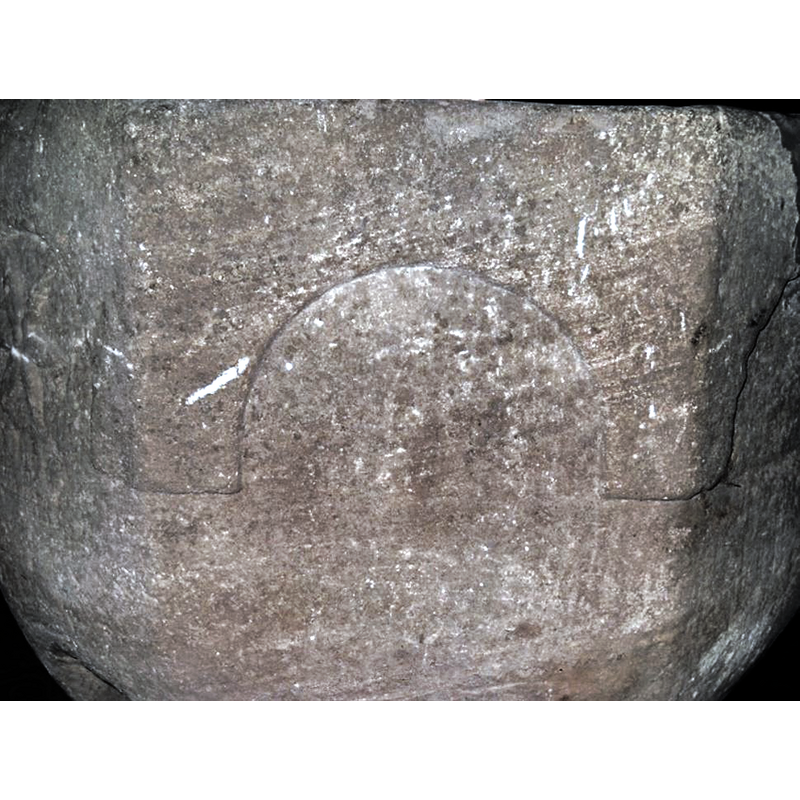
![or, is it a sybol? -- the much-discussed date painted below may have less significance than it is attributed to it by some [cf. FontNotes]](/static-50478a99ec6f36a15d6234548c59f63da52304e5/compressed/1221024021_compressed.png)
![some have identified it as a star; the large side hole may have been made to drain the vessel when it was used as planter in the garden [cf. FontNotes]](/static-50478a99ec6f36a15d6234548c59f63da52304e5/compressed/1221024022_compressed.png)
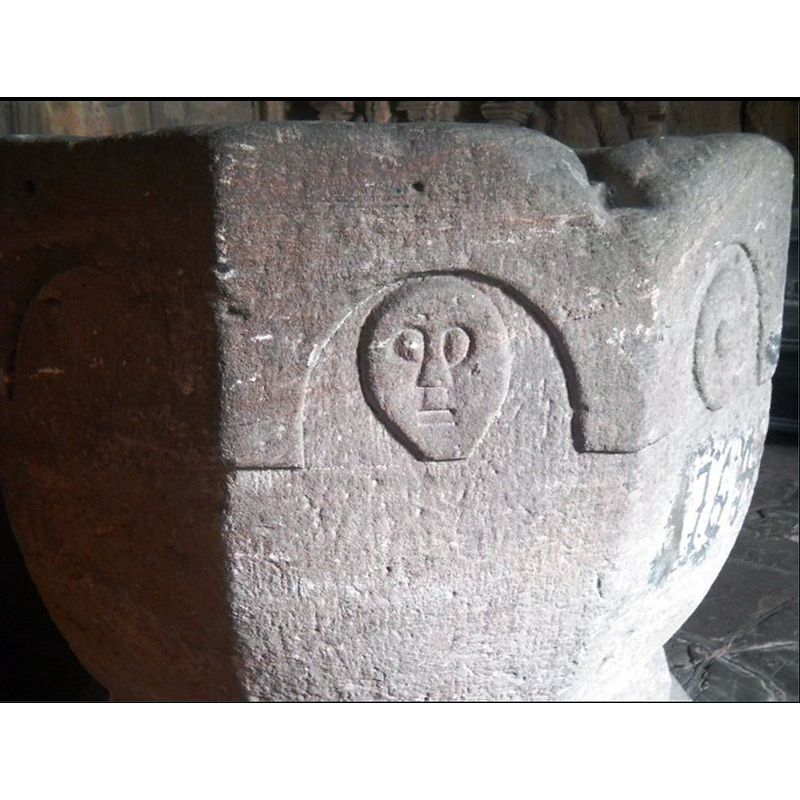
![the original drain or an added side drain? [cf. FontNotes]](/static-50478a99ec6f36a15d6234548c59f63da52304e5/compressed/1221024024_compressed.png)
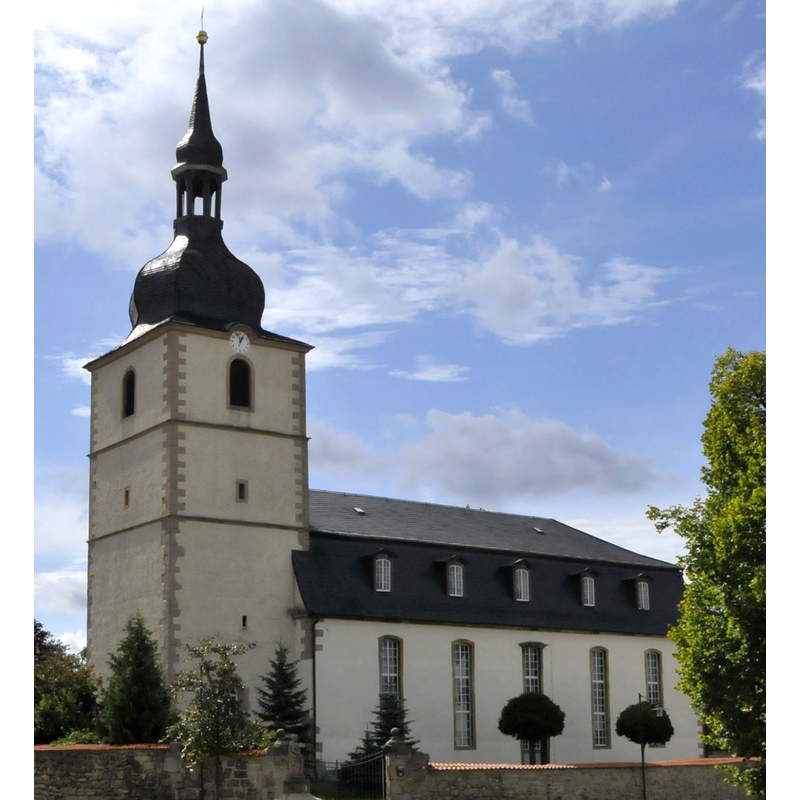
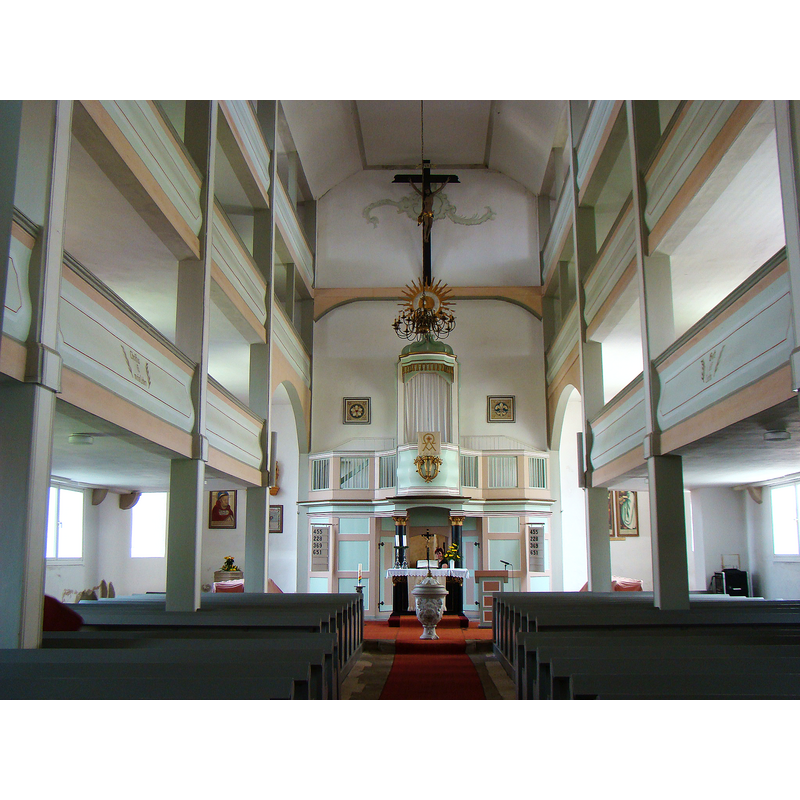
![seen here in the centre is the much-discurred font [cf. FontNotes]](/static-50478a99ec6f36a15d6234548c59f63da52304e5/compressed/1221024015_compressed.png)
![the old font in the context, as displayed in the Schloss Ehrenstein, Ohrdruf [cf. FontNotes]](/static-50478a99ec6f36a15d6234548c59f63da52304e5/compressed/1221024017_compressed.png)
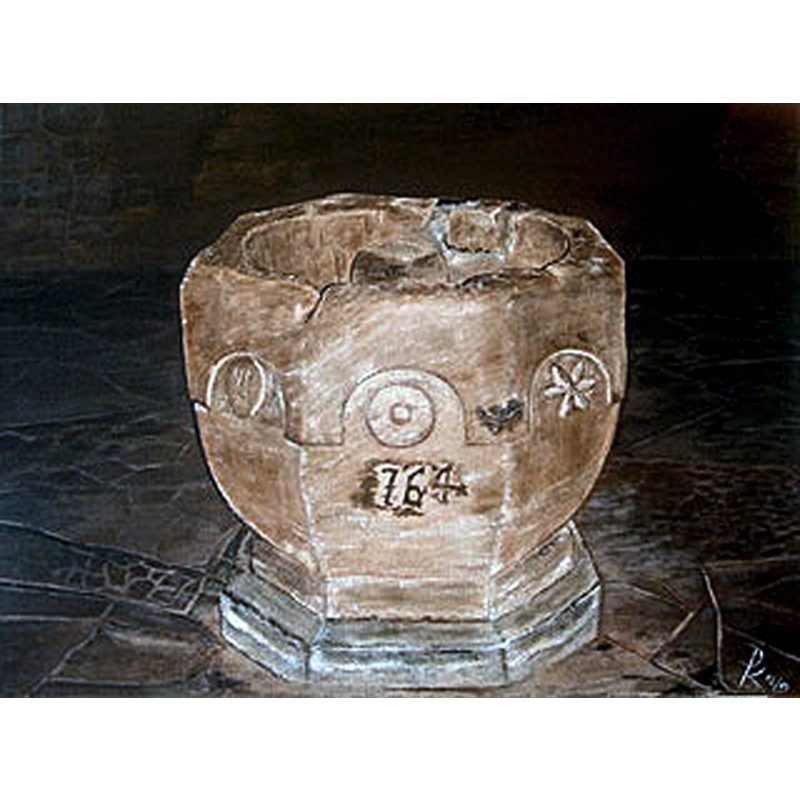
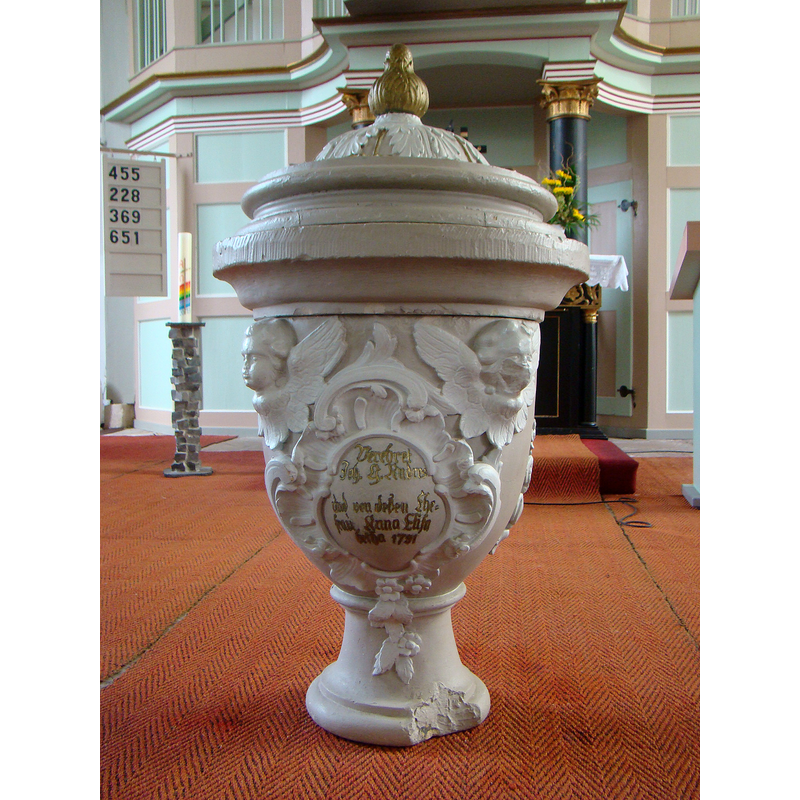
![the old font in the context, as displayed in the Schloss Ehrenstein, Ohrdruf [cf. FontNotes]](/static-50478a99ec6f36a15d6234548c59f63da52304e5/compressed/1221024016_compressed.png)